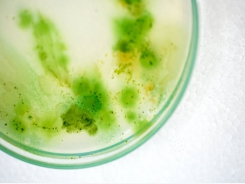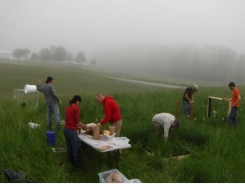Algae detection system aims to help aquaculture bloom

A Scottish consortium is developing an early-warning detection system for potentially dangerous plankton and algae, which could help the aquaculture industry tackle one of the biggest challenges to fish health.
Algal blooms have been responsible for some of the worst instances of farmed salmon mortalities in recent years
The group – comprising of marine technology provider OTAQ, the Iain Fraser Cytometry Centre (IFCC) at the University of Aberdeen, the Scottish Aquaculture Innovation Centre (SAIC), and CENSIS (the Innovation Centre for sensor and imaging systems and Internet of Things technologies) – is creating a low-cost sensor system that can automatically sample, identify, and count specific microscopic organisms using imaging analysis.
Algae and plankton build-up is a major issue in aquaculture – some types of the organisms are toxic to salmon and others, in large quantities, can cause fatal gill damage. Algal blooms, the rapid growth of algae, can occur when there are significant changes to temperature, light, or nutrient conditions. In 2019, a particularly severe case in Norway led to the loss of a substantial number of fish.
Current methods used for monitoring plankton and algae numbers are laborious, relying on readings manually taken once or twice per day. The results are also open to individual interpretation and error. Even some of the more accurate approaches rely on expensive and high-maintenance equipment that only provide a snapshot of algal levels.
Using microscope camera technology and a unique water sampling tool, OTAQ’s new system will use artificial intelligence (AI) deep learning to process images and provide a near real-time reading for fish farmers. The producers can then take preventative measures, such as the activation of a ‘bubble curtain’ or barrier to protect a stretch of water or stop feeding salmon when necessary.
The system is expected to enhance fish wellbeing and better safeguard stocks, improve the use of feed, as well as helping to make the entire water quality monitoring process more efficient and cost effective for producers. OTAQ said several companies have already expressed an interest in the new technology.
Chris Hyde, chief commercial officer at OTAQ, said: “Plankton and algae are a significant problem for the aquaculture industry – substantial stocks of salmon have been lost in the past few years, from Norway to Chile, because of the issue. Early detection of harmful species of plankton and algae has been a sticking point and we’re looking to overcome that problem with our new sensing technology, which will fundamentally automate the process and provide accurate information about plankton numbers 24 hours a day.
“The development of the sensors is the first step towards a more comprehensive early-warning system. This is a strategically important product for us, which will offer salmon farms a better view of what’s happening on their sites and extra data with which they can make decisions – many businesses have already said they need it. The involvement of two of Scotland’s innovation centres and the University of Aberdeen has accelerated the development process significantly and provided us with the scientific grounding to produce accurate, actionable data.”

Algae and plankton build-up is a major issue in aquaculture – some types of the organisms are toxic to salmon and others, in large quantities, can cause fatal gill damage
Dr Raif Yuecel, head of the Iain Fraser Cytometry Centre at the University of Aberdeen, added: “Flow cytometry is a well-established and routinely used quantitative technology to study phytoplankton and algae. The Iain Fraser Cytometry Centre (IFCC) is a state-of-the-art cytometry facility and therefore is the ideal partner to collaborate with OTAQ on this exciting project that will advance an essential aspect of marine science. Experts at the centre will work to validate OTAQ’s AI system for accurate quantitative imaging data and timely assessment of pathogenic marine species using in-house cutting-edge cytometry technology. We are proud to contribute to such an innovative system and set the initial milestone for monitoring live pathogenic planktons in fish farms.”
Caroline Griffin, aquaculture innovation manager at SAIC, said: “This technology could prove a real breakthrough for aquaculture in all salmon-producing countries, enhancing fish wellbeing and health by tackling one of the biggest threats to stocks. In Scotland, it could underpin the Scottish Government’s Farmed Fish Health Framework over the next decade.
"It builds on many of our previous projects around improving fish health and wellbeing, along with reducing the industry’s environmental impact by adopting new technologies from other sectors and applying them to aquaculture.”
Related news
Tools

Phối trộn thức ăn chăn nuôi

Pha dung dịch thủy canh

Định mức cho tôm ăn

Phối trộn phân bón NPK

Xác định tỷ lệ tôm sống

Chuyển đổi đơn vị phân bón

Xác định công suất sục khí

Chuyển đổi đơn vị tôm

Tính diện tích nhà kính

Tính thể tích ao




 Restorative aquaculture: can farming shellfish and seaweed provide…
Restorative aquaculture: can farming shellfish and seaweed provide…  Study suggests antibiotic use alters soil response to…
Study suggests antibiotic use alters soil response to…